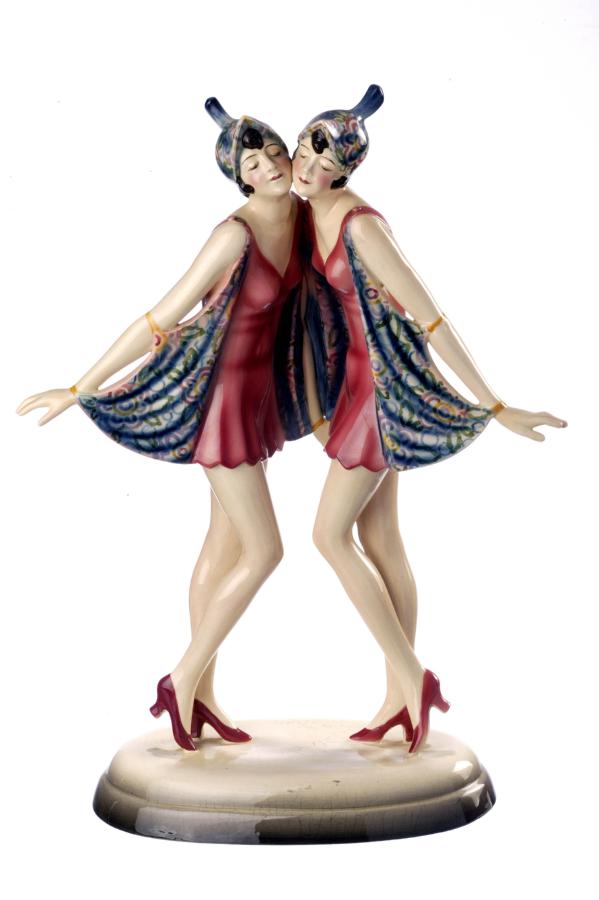Vienna Porcelain
Founded in 1718, the Vienna porcelain factory is the second-oldest in Europe.

Spanish Riding School


"Melon” Mocha Cup
In 1923 the Royal Vienna porcelain factory moved to Augarten Castle, where it still is today. Established under the new name “Augarten”, its ethos was to continue the tradition of the former Imperial manufactory while also making room for fresh ideas. Now as then, porcelain is made and painted by hand, each piece being unique. Augarten is noted for the pure whiteness of it’s porcelain, flawless workmanship and superior painting. Receptive to modern trends, the factory produced designs by contemporary artists including Josef Hoffmann, Michael Powolny, Franz von Zülow, and other representatives of the Vienna Workshops (Wiener Werkstätte). Today, cooperation with well-known artists continues to shape the company’s style and feed its unique flair for combining the traditional with the modern.

Wiener Werkstätte
The Wiener Werkstätte was founded in 1903 by the artist Koloman Moser and architect Josef Hoffmann, both of whom had been key members of the Vienna secession.
The primary goal of the company was to bring good design and craft into all areas of life within the fields of ceramics, fashion, silver, furniture, and the graphic arts. It was in keeping with the Vienna Secession’s idea of the Gesamkustwerk- a total work of art. Just as the Vienna Secession had reacted against the old neo-classical style of the ‘Association of Austrian Artists’, the Wiener Werksätte had initially been promoted as a declaration of modernity over the old order.
A small pamphlet from 1905 outlined their program:
“The limitless harm done in the arts and crafts field by low quality mass production on the one hand and by the unthinking imitation of old styles on the other is affecting the whole world like some gigantic flood…It would be madness to swim against this tide. Where appropriate we shall try to be decorative without compulsion and not at any price”
From the onset, the Wiener Werkstätte encouraged its patrons to look beyond the material value of objects and to embrace geometric symmetry over surface ornament. We need only to look at Moser’s logo design and the flower motif based on the golden section to see how much these architectural principles dictated the company’s early designs.
The Wiener Keramik was created by Michael Powolny and Barthold Löffler in 1906, in 1907 the Wiener Werkstätte buys the Wiener Keramik models to be sold at the WW stores. 1912 and the Wiener Keramik joins Gmunder Keramik in order to be able to satisfy an increasing demand for it’s products. From 1914 many designers from the Wiener Werkstätte started creating for Gumundner, and in 1916 the Wiener Werkstatte founded its own ceramics workshops.
In 1919, Wiener Keramik disappears and only Gmunder Keramik remains, still producing the popular Powolny designs.
 Goldscheider Ceramics
Goldscheider Ceramics
The ” Goldscheider Porzellan-Manufactur und Majolica-Fabrik ” was founded in 1885 by Friedrich Goldscheider in Vienna. Within a short period of time Goldscheider earned wide international acclaim together with notable awards and established itself as a leading ceramic company first in Vienna and soon throughout Europe. With international branches opening in Paris, Leipzig, Berlin and Florence Friedrich’s sons Walter and Marcell were able to further expand the business in the 1920’s and 30’s.
Goldscheider was setting the standards and style for Art Déco ceramics with an enormous success all over the world – creating some of the most beautiful and striking models which continue to be very much in demand to the present day. Only the rise of Hitler and fascism could have halted the unique artistic and business achievements of the Viennese family.
Notable Austrian Sculptors
- Stefan Dakon 1904-1992 Vienna, one of the most important designers of ceramic wall masks and figures for Goldscheider and Keramos, worked in close association with Lorenzl;
- Prof. Albin Dobrich 1872-1945, renowned artist at Augarten 1924-30, produced eight figures for the Spanish Riding School series;
- Klara Herczeg/Claire Weiss 1906-1997, Hungarian artist who designed 65 figures for Goldscheider;
- Mathilde Jaksch 1899-?? Vienna, designed many beautiful figures for Augarten during the 1920s and 30s;
- Prof. Robert Ullman 1903-1966 Vienna, sculpted countless figures in marble and for the porcelain manufactory Augarten;
- Karin Jarl-Sakellarios 1885-1945, Ceramist at the Augarten factory from 1925.
- Rudolf Kaesbach 1873-1955, Berlin sculptor who produced a few figures for the Goldscheider factory;
- Rudolf Knorlein 1902-1988 Vienna, famous for his colours and new glazes at Weiner Werkstatte and Gumunder Keramik, also Goldscheider;
- Josef Lorenzl 1892-1950 Vienna, master designer his figures of women epitomise the art deco era;
- Ida Meisinger 1897-1985 Viennese sculptor at Goldscheider;
- Charlotte Monginot 1872-1962, French sculptor in marble and plaster, Goldscheider Paris ;
- Rudolf Podnay 1876-1963 Viennese Ceramist a partner at Keramos and Wiener Keramik;
- Michael Powolny 1871-1954, founder of the Viennese ceramics Wiener Werkstatte;
- Adolf Prischl 1912-1970 Vienna, models for Goldscheider and Keramos until 1947 when he set up his own factory;